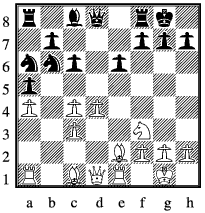
May 2010
Second division
| ||||||||||||||||||||||||||||||||||||||||||||||||||||||||||||
Fifth division
|
The second division leadership changed hands again, with Macclesfield completing their fixtures to set a target that only Cheddleton B and Newcastle B might chase down. That the two clash on May 7th just adds further spce and uncertainty to the competition.
At the other end of the table Fenton's two victories during April have lifted them from the foot of the table, with the holmes Chapel teams now looking destined to contest the wooden spoon.
Division five is now down to postponements, which hasn't stopped Fenton adding to the list with their latest show of reluctance to travel to Cheddleton putting the potential end of season for the division back to 28th May, a good six weeks after the original 14th April. Enough to make outsiders hope that Fenton lose their top spot.
On the cup front all the finals were played in the week that had been set aside for them, though this was a near run thing as Fenton threatened to further postpone their Perry Trophy semi-final at Cheddleton which had already been put back to the Friday before the finals week. Fortunately John Amison decided that this was unacceptable nonsense and stepped in to twist a few arms. Fenton went on to win this semi-final, only to lose at home in the final against Newcastle on the Monday of finals week. On the same night Cheddleton won the Major Cup at Meir in a match that the hosts will probably wish me to gloss over. Two days later Newcastle also picked up the Intermediate cup by defeating Holmes Chapel at the Bridge Club. The heavyweights of the Open Cup were last into action with on the Friday. In a match that reportedly did justice to this cup's status of the NSDCA's premier competition Holmes Chapel edged past Cheddleton to complete an Open league and cup double.
On the county front the U140 team were the only side in action in April, taking on Yorksire in a national stage preliminary round match. Yorkshire did not seek a neutral venue, being prepared to travel to Newcastle for the match which the hosts proceeded to win.
Two of the county cups also travel north this year with Cheddleton winning the Jackson Cup and Newcastle the Withnall, though the county's insistence that the matches be played on a date announced with relatively short notice did nothing to encourage future involvement.
comment on this article
RR's opponent on the night was Phil Birks, and with the black pieces it did not take long for RR to reach the highly inferior position shown left.

|
| Phil Birks v RR after 11 ... Na6 |
12 Bd3 f6, 13 Bc2 c5, 14 Qd3 g6, 15 h4 cxd4
16 cxd4 Nb4 The knight is put to good use, though black's kingside pawn formation hardly represents a solid defence.
17 Qc3 Nxc2, 18 Qxc2 Qc7, 19 Ba3 Re8 At the time it seemed natural to provide extra defence to the e-pawn, but the 7th rank is also a problem and Rf7 may well be better.
20 Rac1 Bd7 I'm back in the game (see right).
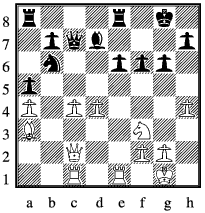
|
| Phil Birks v RR after 20 ... Bd7 |
23 Rb1 Ra6, 24 h6 (Attempting to make queenside gains is not a good idea:
24 Bc5 Nd7, and if 25 Rxb7 Nxc5 will be a considerable disappointment for white.)
24 ... Bc6, 25 Rb2 g5, 26 Rbe2 Bxf3, 27 Qxf3 Nxc4
The timing of this is wrong. I had originally thought to keep my bishop on and aiming at g2, so g5 (which I had declined to play earlier!) was aimed at the white knight. However
25 ... Bxf3, 26 Qxf3 Nxc4, 27 Rxb7 Nd2 and white loses the exchange. Consequently white has to vary with either
26 gxf3 or 27 not Rxb7, either of which leaves me relatively comfortable. The annoying thing is that I saw this at the time, but didn't go for it.
28 Bc5 b5 I wanted to play b6 hitting the bishop, but was afraid of Qc6 in reply. Although annoying this queen move would be preferable to
28 ... b6, 29 Rxe6 Rxe6 (Raa8 and Rb8 fare no better)
30 Rxe6 Qxe6, 31 Qb7 with irresistable mate threats. I seem to have got away with discounting a blunder for the wrong reasons!

|
| Phil Birks v RR after 28 ...b5 |
As so often I now lacked a plan. Alex had already drawn on top board, but no-one else appeared to have a clear cut position, so playing for the win seemed necessary. How? All white's pieces are actively placed. The otherwise desirable Qg6 allows Qb7 which is not healthy. e5 feels best (my silicon friend concurs), though I can't see where its going, so in the end I chose
29 ... Rc6, 30 f4 Qc7, 31 Qg4 Qxf4, 32 Qh5 Qb8
By now the positions on other boards left me satisfied with a draw.
32 ... Rec8 looks a good way of getting this:
33 Rxe6 Rxe6, 34 Rxe6 Qc1+, but I was unable to convince myself that white had no viable alternative to this line, so chose not to play it.
33 Rf1 Qd8 Disaster. 34 Rxf6 and black is lost, though RR played on 'til closer to mate.
More disaster. A win from Francis and draws on the other boards meant that a draw from me would have secured our prime objective. I'm going to cry.
comment on this article
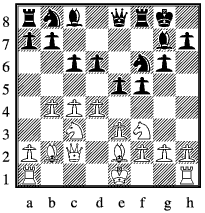
|
| RR v Phil Birks after 9 ... e5 |
10 dxe5 dxe5, 11 e4 Na6 declining the offer of play with an isolated King pawn
12 a3 Nc7, 13 0-0 Ne6, 14 exf5 placing a rook on the d-file is surely better
14 ... Nd4, 15 Nxd4 exd4, 16 Na4 Bxf5
17 Bd3 Bxd3, 18 Qxd3 Qe4, 19 Qxd4 Qc2=
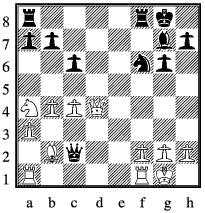
|
| RR v Phil Birks after 19 ... Qc2= |
20 Qd1 Qxc4, 21 Rc1 Qf7, 22 Qc2 Rfe8, 23 Rcd1 Rad8=
This second draw offer may be close to the first in moves, but came quite a bit later timewise as I had spent much time searching (unsuccessfully) for an obvious plan to justify continuation. Again, whilst sorely tempted to accept I didn't feel the unresolved positions on other boards allowed me to.
24 Bd4 b6, 25 f3 Intended as creating a retreat for the bishop and keeping the black knigt out of g4, but in truth getting my own knight into the game is more important.
25 ... Bh6, 26 Bf2 Be3
More bits coming off here. BxB or RxR. I go for the former, so you won't be surprised that Fritz prefers the latter.
27 Bxe3 Rxd1, 28 Rxd1 Rxe3, 29 Qxc6 Qe7
30 Qc1 Nd5, 31 Kf1 Qe5
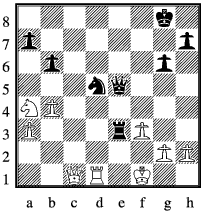
|
| RR v Phil Birks after 31 ... Qe5 |
32 Qc4 Kg7, 33 Qxd5
About time I made a fully fledged blunder. Still it could have been worse - RxN would have allowd Qa1+with mate to follow quickly.
33 ... Re1+, 34 Kf2 Compounding the error, leaving Phil with a couple of pieces to coordinate. Going for R+N+P v Q would be saner.
34 ... Qe2+, 35 Kg3 Rxd1, 36 Qb7+ Kh6
Shoring up my defence looks nigh on impossible, so grab pawns and hope there is no quick mate:
37 Qxa7 Rg1, 38 Qxb6 Qxg2+, 39 Kf4
Fritz is now declaring mate in double figures, but with little thinking time it is no surprise that neither side found the best moves. Phil's mate or bust attack ended in bust on move 51 with his mate threats gone and time about to follow suit.
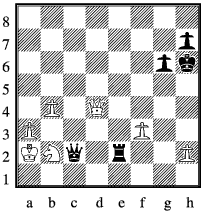
|
| RR v Phil Birks final position after 51 Ka2 |
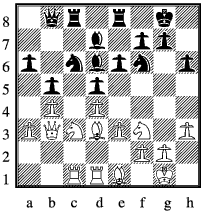
|
| RR v Malcolm Roberts after 17 ... h6 |
Back to RR's game. Four possibilities:
i) Nothing continues to happen and we shake hands on a draw.
ii) Someone shoves an a-pawn
iii) Someone shoves an e-pawn
iv) Someone shoves a g-pawn.
Arranging any of the shoves to advantage seems to entail some risk, but i) is not on my agenda. Preparing ii) is too slow, and I'm not brave enough for iv) so
18 e4 dxe4, 19 Bxe4 betraying my liking for closed positions and hoping for
19 ... Nxe4, 20 Nxe4 after which the knight gets to alight on c5.
19 ... Ne7, 20 Bb1 compounding the error of capturing with the wrong minor by vacating the h1a8 diagonal. Qb1 was called for. Now black's bishops get to dominate the board.
20 ... Bc6, 21 Nd2 Qb7, 22 f3 What else? A good illustration as to why I don't like moves such as h3. It's not the first pawn move in front of the castled king that weakens his position but the second one. However the first one brings the second one nearer. In this position f3 was the second move, and it is plain that there are now plenty of holes in front of the king for black's minor pieces to exploit at his leisure.
22 ... Ned5, 23 Nce4 Nxe4, 24 Nxe4 Why not fxe4? Because my mind was elsewhere. 'Tis the only explanation.
24 ... Bb8, 25 Bf2 Nf4, 26 Re1 Bd5, 27 Qb2 Bxe4 unexpected
28 Bxe4 Qe7 (right)
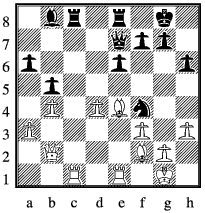
|
| RR v Malcolm Roberts after 28 ... Qe7 |
29 ... Qg5 (Rxc1 even stronger as recapturing with the rook invites exd5 with access to e2, recapturing with the queen removes second rank defence)
30 Bc5 (Be3 less bad as it forces black to be more careful with the placement of his attacking pieces.)
30 ... exd5, 31 Bb1 Nxh3+ Predictable. Black is now two pawns up to go with his attack. Readers with a little time to spare however will enjoy considering the lines that arise following the less predictable (at my level) 31 ... Re2.
However there was to be no escape for RR and he resigned 10 moves later with mate imminent.
Elsewhere Paul had won on bottom board to leave the match level with just Alex in action with an edge in a queen and pawn ending against Jon Blackburn. Fortunately for my nerves I couldn't see the face of the digital clocks, for when Jon's flag fell to give Alex and us victory, Alex had a mere three seconds left himself. So the night wasn't a complete disaster for RR.
comment on this article